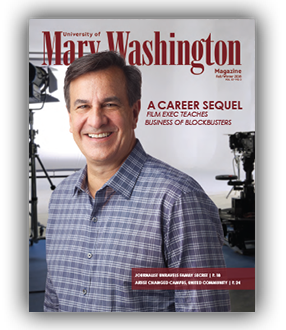By Kristin Davis
Johnny P. Johnson had taught first through 12th grades for a decade, coached basketball, and given art lessons to inmates. He was also an artist in his own right, with a following of Washington, D.C., professionals who drove to Fredericksburg to buy his work.
But in 1968, the year Mary Washington came calling, he’d never instructed on a college campus. In fact, a civil rights group of which Johnson served as president had once been barred from holding meetings on campus because its membership was integrated. Now the college wanted Johnson to teach an art education class.
Times were changing. So was Mary Washington. Johnson accepted the job, becoming the first African-American faculty member. He stayed on as an adjunct professor for two decades, as his reputation as an artist, educator, and humanitarian burgeoned far beyond the region.
Over the summer, Fredericksburg honored those achievements with the first-ever Johnny P. Johnson Day on July 7. UMW further honored Johnson with a private luncheon at the president’s residence at Brompton.

“He came at a time when the university was making a choice to be more active and intentional in its efforts toward diversity and inclusion and civil rights,” said Sabrina Johnson, UMW’s vice president for equity and access and chief diversity officer. “It’s important to remember that, and to celebrate that as we continue in this journey.”
Johnson was an artist before he fully understood what the word meant. At age 3, on a church pew next to his mother in their native Henderson, North Carolina, he outlined figures in the air. When he went off to school, he filled up the margins of his textbooks with drawings and spent hours making sketches on inexpensive typing paper.
He loved music, especially the blues of Blind Boy Fuller, whose records he listened to on Victrola. And he excelled at sports – he would go on to captain the basketball team at what’s now Virginia State University and earn a spot in VSU’s Sports Hall of Fame.
His sister Helen, six years his senior, enforced diction and gentlemanly manners, teaching him to stand when a lady entered the room and walk on the outside of the sidewalk in the company of women.
“She had me quoting Shakespeare in seventh grade,” Johnson said. When he went off to college, she sent his letters back with corrections.
In 1959, Johnson accepted a job at Walker-Grant school in Fredericksburg, where he taught sixth grade and art for all grades. When Fredericksburg schools at last desegregated, Johnson began teaching art at James Monroe High School.
By then a husband and father, Johnson also was active in the burgeoning civil rights movement. After Martin Luther King Jr. was assassinated in April 1968, Johnson helped channel the anger of that emotionally fraught time into a Young Men’s Club. And he served as president of the Fredericksburg Council on Human Relations, a group of black and white city residents and Mary Washington students.
By then, integration also had come to the college campus. Mary Washington enrolled its first African-American student in 1962, formally desegregated two years later, and had its first African-American graduates in 1968.
Johnson was surprised to be asked to teach at the university, but he threw himself into the job. He modestly recalls, “I think I did pretty well as a teacher.”
He was, in fact, beloved.
“What’s so special to me about him is there are very few people in this world who don’t see black or white. I think all of us have some prejudices. He loves everybody,” said Gaye Adegbalola, a Fredericksburg native and blues singer who was Mary Washington’s second African-American student.
He gave constantly to his students and community, Adegbalola said. That spoke not only to Johnson’s character but that of his wife, Jean, and his two sons, who shared him with the community that loved him.
As an art education professor, Johnson introduced artists both black and white. “I told [students] to keep in mind that they might get a job in a predominantly black community. I would share some personal experiences,” Johnson said.
When a Mary Washington student asked him for a tube of flesh-colored paint, Johnson handed over a black one. “It was not to be funny, but to bring their attention to the fact that none of us are the same. You can take 10 white kids, and can’t find a color to fit just one. Sometimes, you have to mix the paint.”
Later, after they became educators themselves, many came back to him, telling him his lessons were right on target. “Those are the things I really appreciate,” Johnson said.
Busy as he was with teaching and community involvement, Johnson also was a prolific artist. Today, his paintings hang in embassies, banks, hospitals, and homes as far-flung as Europe and Africa. His work took him to Jamaica and the African nation of Benin as the guest of longtime friend and U.S. Ambassador Pamela Bridgewater, herself a collector of Johnson’s art.
A stroke two years ago slowed Johnson down, but he still picks up his brushes a few times a week. And although he has long retired from collegiate and public school teaching, he still gives art workshops at the city’s community center.
While he was gracious about Johnny P. Johnson Day, the fuss made him a little uncomfortable.
“I guess you might say I was slightly embarrassed,” Johnson said. “A lot has been given to me. The things I’ve done that people make a note of – they are things I think I was supposed to do.”
Maybe so. But as President Troy D. Paino noted in a Free Lance-Star newspaper article about Johnson, the artist’s actions in the community and the classroom had positive, long-lasting effects.
“Johnny P. Johnson paved the way for a new era,” Paino said.



